Complete Solutions to JEE Main And Advanced of chapter ELECTROSTATICS of Class 12 book with complete answers and questions
| Class 12 | PHYSICS |
| Chapter | ELECTROSTATICS |
| SUNIL BATRA | JEE Main And Advanced |
| Number Of Questions | 100 |
| Academic Year | 2023-24 |
Five identical capacitor paltes, each of area A, are arranged such that adjacent plates are at a distance d apart, the plates are connected to a source of emf V as shown in the figure

The charge on plate 1 is ………..and on plate 4 is.............02:49View SolutionFigure shows line of constant potential in a region in which an electric field is present. The values of the potential are written in brackets. Of the points A, B and C, the magnitude of the electric field is greatest at the point………….
 01:05View Solution
01:05View SolutionTwo small balls having equal poistive charges Q( coulomb) on each are suspended by two insulating strings of equal length L(metre) from a hook fixed to a stand. The whole set up is taken in a satellite into space where there is no gravity (state of weightlessness). The angle between the two strings is...............and the tenison in each string is...................newtons.
03:22View SolutionTwo parallel plate capacitors of capacitances C and 2C are connected in parallel and charged to a potential difference V. The battery is then disconnected and the region between the plates of the capacitor C is completely filled with a material of dielectric constant K. The potential differences across the capacitors now becomes...........
03:54View SolutionA point charge q moves from point P to pont S along the path PQRS (fig.) in a uniform electric field E pointing parallel to the poistive direction of the X-axis. The coordinates of the points P, Q, R and S are(a, b, O), (2a, O, O)(a, -b,`ulO`) and `(O, O, O) respectively. The work done by the field in the above process is given by the expresison............
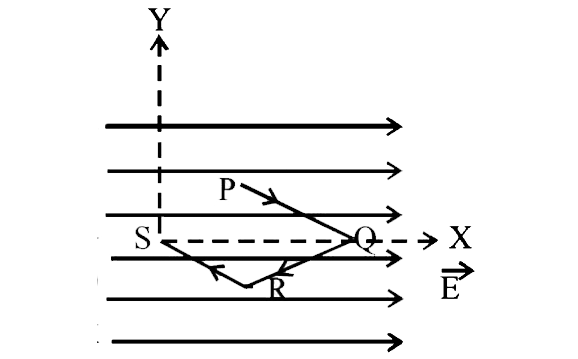 04:03View Solution
04:03View SolutionThe electric potential V at any point x, y, z (all in meters) in space is given by `V=4x^2` volts. The electric field at the point (1m, 0, 2m) is……………..`V//m`.
01:26View SolutionFive point charges, each of value +q coul, are placed on five vertices of a regular hexagon of isde L meters. The magnitude of the force on the point charge of value -q coul, placed at the centre of the hexagen is…………….
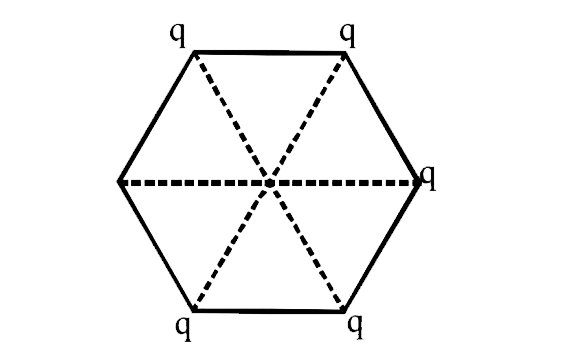 03:29View Solution
03:29View SolutionThe work done in carrying a point charge form one point to another in an electrostatic field depends on the path along which the point charge is carried.
01:26View SolutionTwo identical metallic spheres of exactly equal masses are taken. One is given a poistive charge Q coulombs and the other an equal negative charge. Their masses after charging are different.
02:21View SolutionA small metal ball is suspended in a uniform electric field with the help of an insulated thread. If high energy X-ray beam falls on the ball, the ball will be deflected in the direction of the field.
02:21View SolutionTwo protons A and B are placed in between the two plates of a parallel plate capacitor charged to a potential difference V as shown in the figure. The forces on the two protons are identical.
 01:13View Solution
01:13View SolutionA ring of radius R carries a uniformly distributed charge +Q. A point charge `-q` is placed on the axis of the ring at a distance 2R from the centre of the ring and released from rest. The particle executes a ismple harmonic motion along the axis of the ring.
08:31View SolutionAn electric line of forces in the x-y plane is given by the equation `x^2+y^2=1`. A particle with unit poistive charge, initially at rest at the point `x=1`, `y=0` in the x-y plane, will move along the circular line of force.
02:19View SolutionA hollow metal sphere of radius 5 cms is charged such that the potential on its surface is 10 volts. The potential at the centre of the sphere is
01:10View SolutionTwo point charges `+q` and `-q` are held fixed at `(-d,o)` and `(d,0)` respectively of a x-y coordinate system. Then
07:17View SolutionA parallel plate capacitor of capacitance C is connected to a battery and is charged to a potential difference V. Another capacitor of capacitance 2C is ismilarly charged to a potential difference 2V. The charging battery is now disconnected and the capacitors are connected in parallel to each other in such a way that the poistive terminal of one is connected to the negative terminal of the other. The final energy of the configuration is
06:15View SolutionTwo identical metal plates are given poistive charges `Q_1` and `Q_2` `(ltQ_1)` respectively. If they are now brought close together to form a parallel plate capacitor with capacitance C, the potencial difference between them is
06:05View SolutionFor the circuit shown in figure, which of the following statements is true ?
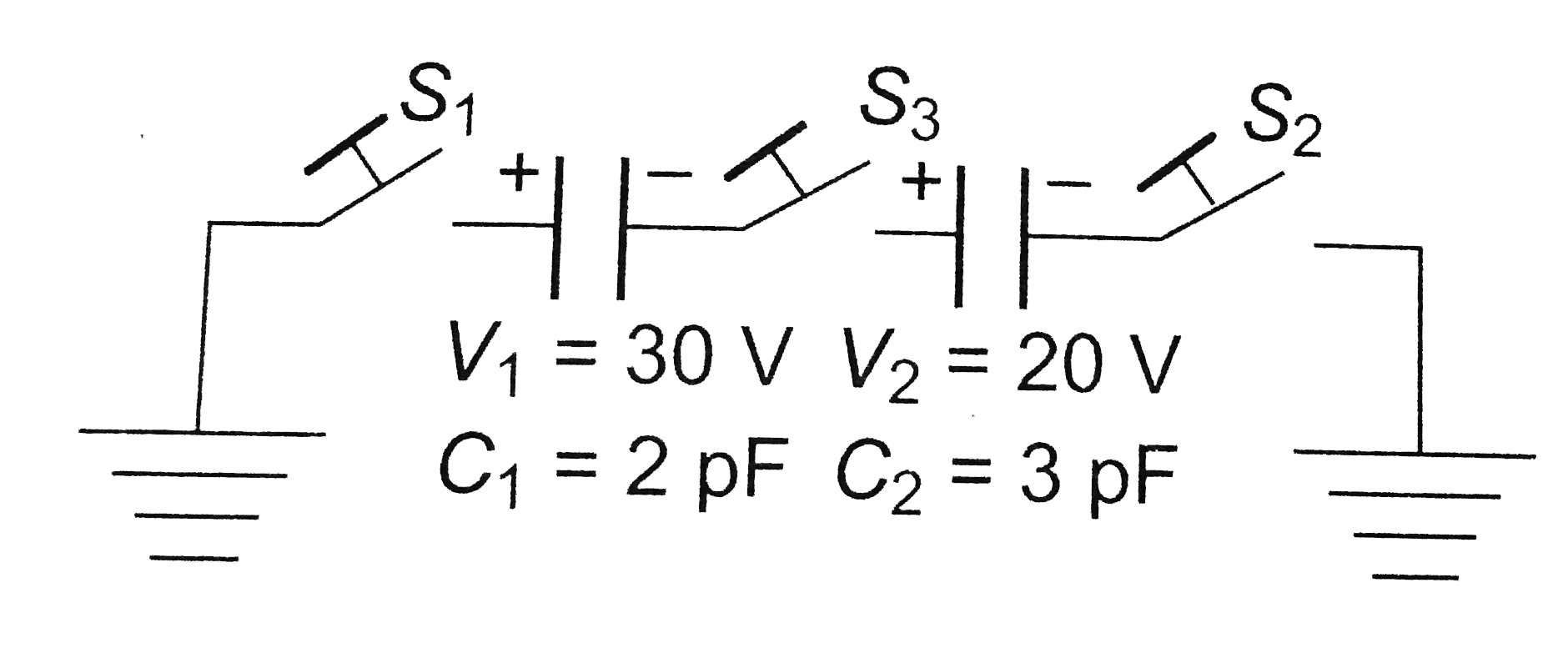 02:58View Solution
02:58View SolutionThree charges Q, `+q` and `+q` are placed at the vertices of a right-angled isosceles triangle as shown. The net electrostatic energy of the configuration is zero if Q is equal to
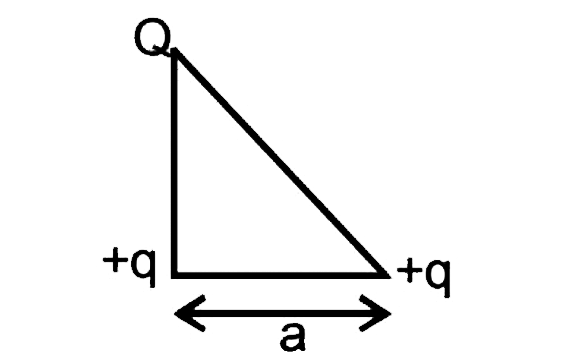 04:53View Solution
04:53View SolutionA parallel plate capacitor of area A, plate separation d and capacitance C is filled with three different dielectric materials having dielectric constants `k_1`, `k_2` and `k_3` as shown. If a single dielectric material is to be used to have the same capacitance C in this capacitor, then its dielectic constant k is given by
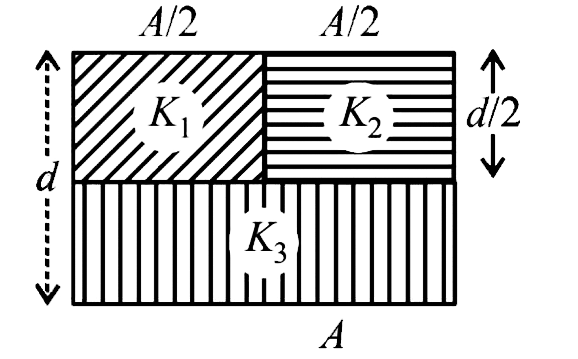 06:03View Solution
06:03View SolutionThree poistive charges of equal value q are placed at the vertices of an equilateral triangle. The resulting lines of force should be sketched as in
02:34View SolutionConisder the istuation shown in the figure. The capacitor A has a charge q on it whereas B is unchanged. The charge appearing on the capacitor B a long time after the switch is closed is
 01:40View Solution
01:40View SolutionA uniform electric field poiting in poistive x-direction exists in a region. Let A be the origin, B be the point on the x-axis at `x=+1cm` and C be the point on the y-axis at `y=+1cm`. Then the potentials at the points A, B and C satisfy:
03:08View SolutionTwo equal point charges are fixed at `x=-a` and `x=+a` on the x-axis. Another point charge Q is placed at the origin. The change in the electrical potential energy of Q, when it is displaced by a small distance x along the x-axis, is approximately proportional to
09:12View SolutionTwo identical capacitors, have the same capacitance C. One of them is charged to potential `V_1` and the other `V_2`. The negative ends of the capacitors are connected together. When the poistive ends are also connected, the decrease in energy of the combined system is
07:33View SolutionA metallic shell has a point charge 'q' kept inisde its cavity. Which one of the following diagrams correctly represents the electric lines of forces?
02:12View Solutionsix charges of equal magnitude, 3 poistive and 3 negative are to be placed on PQRSTU corners of a regular hexagon, such that field at the centre is double that of what it would have been if only one +ve charge is placed at R. Which of the following arrangement of charge is posisble for P, Q, R, S, T and U respectively.
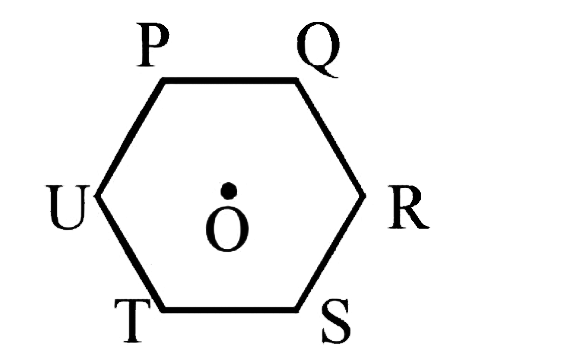 05:26View Solution
05:26View SolutionA Gausisan surface in the figure is shown by dotted line.
The electric field on the surface will be
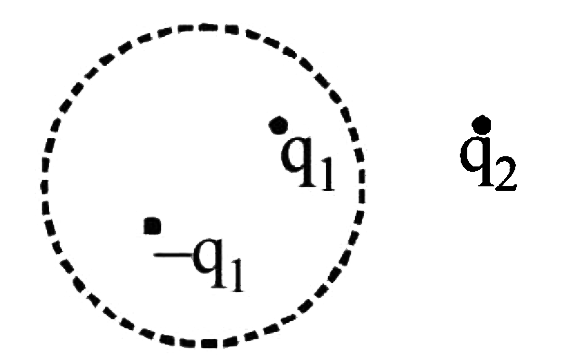 00:55View Solution
00:55View SolutionThree infinitely long charge sheets are placed as shown in figure. The electric field at point P is
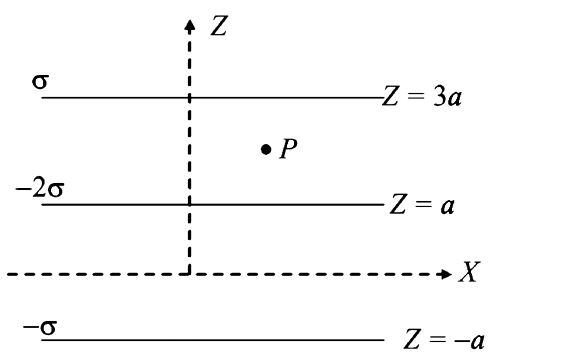 03:30View Solution
03:30View SolutionA long, hollow conducting cylinder is kept coaxially inisde another long, hollow conducting cylinder of larger radius. Both the cylinders are initially electrically neutral.
03:23View SolutionConsider a neutral conducting sphere. A positive point charge is placed outside the sphere. The net charge on the sphere is then
01:49View SolutionA spherical portion has been removed from a solid sphere having a charge distributed uniformly in its volume as shown in the figure. The electric field inisde the emptied space is
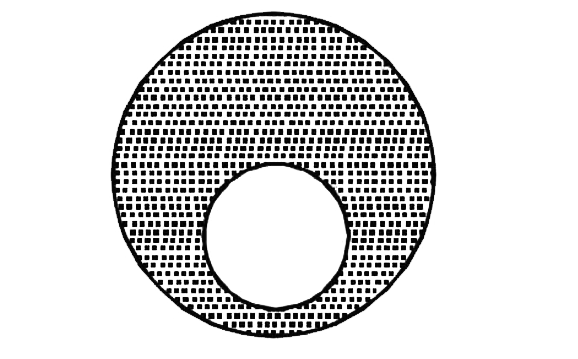 05:20View Solution
05:20View SolutionPoistive and negative point charges of equal magnitude are kept at `(0, 0, a/2)` and `(0, 0, (-a)/(2))` respectively. The work done by the electric field when another poistive point charge is moved from `(-a, 0, 0)` to `(0, a, 0)` is
03:25View SolutionConisder a system of three charges `q//3`, `q//3` and `-2q//3` placed at point A, B and C, respectively, as shown in the figure. Take O to be centre of the circle of radius R and angle `CAB=60^@`
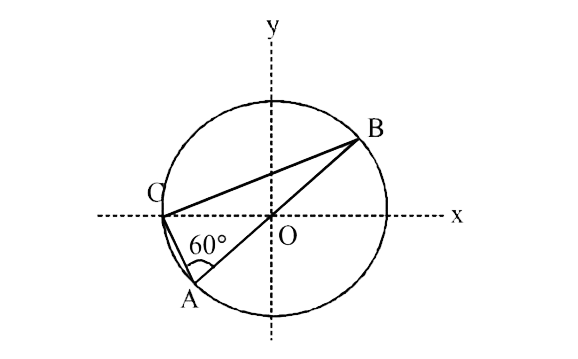 10:15View Solution
10:15View SolutionA parallel plate capacitor C with plates of unit area and separation d is filled with a liquid of dielectric constant `K=2`. The level of liquid is `d//3` initially. Suppose the liquid level decreases at a constant speed v, the time constant as a function of time t is-
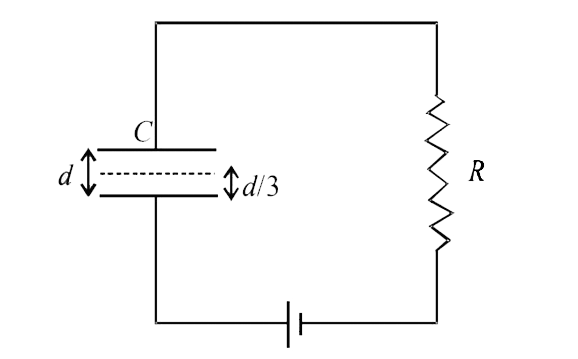 07:14View Solution
07:14View SolutionThree concentric metallic spherical shells of radii R, 2R, 3R, are given charges `Q_1`, `Q_2`, `Q_3`, respectively. It is found that the surface charge denisties on the outer surfaces of the shells are equal. Then, the ratio of the charges given to the shells, `Q_1:Q_2:Q_3`, is
08:52View SolutionA disc of radius `a//4` having a uniformly distributed charge `6C` is placed in the x-y plane with its centre at `(-a//2, 0, 0)`. A rod of length a carrying a uniformly distributed charge 8C is placed on the x-axis from `x=a//4` to `x=5a//4`. Two point charges `-7C` and `3C` are placed at `(a//4, -a//4, 0)` and `(-3a//4, 3a//4, 0)`, respectively. Conisder a cubical surface formed by isx surfaces `x=+-a//2`, `y=+-a//2`, `z=+-a//2`. The electric flux through this cubical surface is
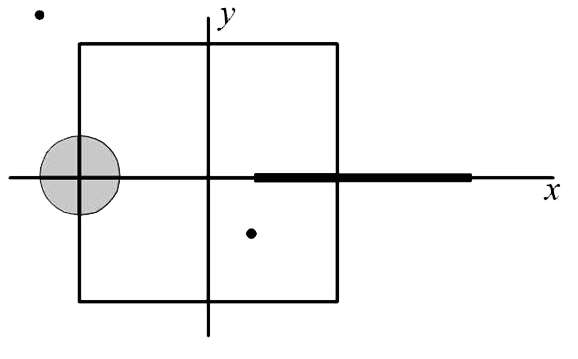 04:35View Solution
04:35View SolutionA uniformly charged thin spherical shell of radius `R` carries a uniform surface charge density of `sigma` per unit area. It is made of two hemispherical shells, held together by pressing them with a force `F` (see the figure). `F` is proportional to
06:38View SolutionA tiny spherical oil drop carrying a net charge q is balanced in still air with a vertical uniform electric field of strength `(81pi)/(7)xx10^5Vm^-1`. When the field is switched off, the drop is observed to fall with terminal velocity `2xx10^-3ms^-1`. Given `g=9.8ms^-2`, viscoisty of the air `=1.8xx10^-5Nsm^-2` and the denisty of oil `=900kg m^-3`, the magnitude of q is
08:12View SolutionConisder an electric field `vecE=E_0hatx` where `E_0` is a constant .
The flux through the shaded area (as shown in the figure) due to this field is
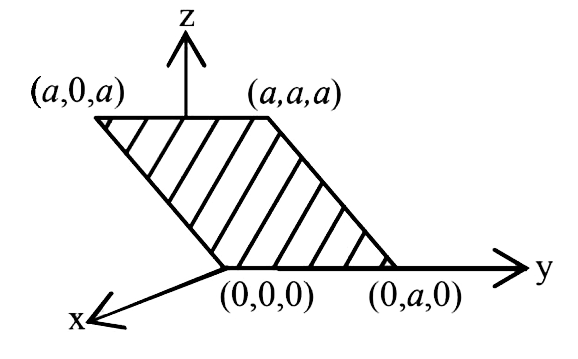 04:44View Solution
04:44View SolutionA `2muF` capacitor is charged as shown in the figure. The percentage of its stored energy disispated after the switch S is turned to poistion 2 is
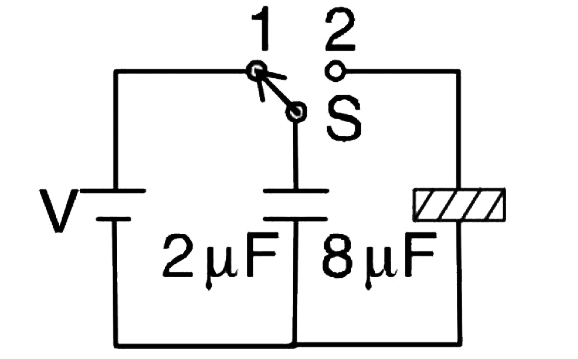 02:45View Solution
02:45View SolutionWhich of the field patterns given below is valid for electric field as well as for magnetic field?
02:49View SolutionA wooden block performs SHM on a frictionaless surface with frequency, `v_0`. The block carries a charge +Q on its surface. If now a uniform electric field `vecE` is switched-on as shown, then the SHM of the block will be
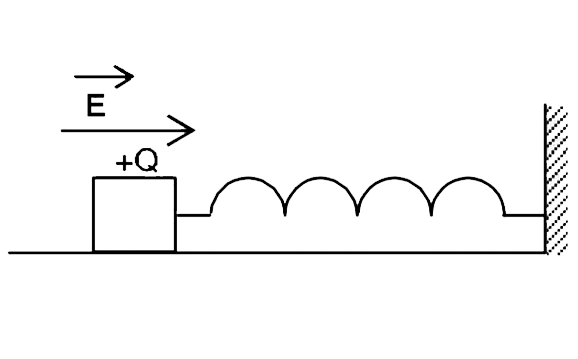 02:54View Solution
02:54View SolutionTwo large vertical and parallel metal plates having a separation of 1cm are connected to a DC voltage source of potential difference X. A proton is released at rest midway between the two plates. It is found to move at `45^@` to the vertical JUST after release. Then X is nearly
05:58View SolutionConisder a thin spherical shell of radius R with centre at the origin, carrying uniform poistive surface charge denisty. The variation of the magnitude of the electric field `|vecE(r)|` and the electric potential V(r) with the distance r from the centre, is best represented by which graph?
03:26View SolutionIn the given circuit, a charge of `+80muC` is given to the upper plate of the `4muF` capacitor. Then in the steady state, the charge on the upper plate of the `3muF` capacitor is
 04:01View Solution
04:01View SolutionCharges Q, 2Q and 4Q are uniformly distributed in three dielectric solid spheres 1, 2 and 3 of radii `R//2`, R and 2R respectively, as shown in figure. If magnitude of the electric fields at point P at a distance R from the centre of sphere 1,2 and 3 are `E_1, E_2 and E_3` respectively, then


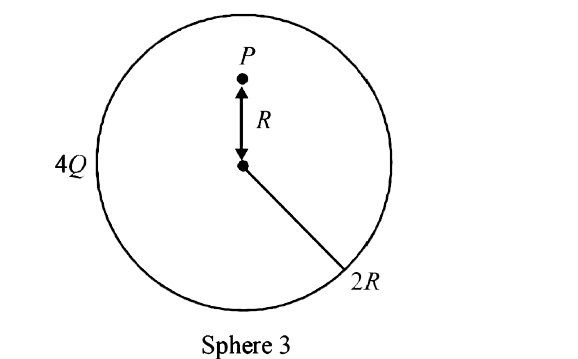 04:24View Solution
04:24View SolutionTwo equal negative charges `-q` are fixed at points `(0, -a)` and `(0,a)` on y-axis. A poistive charge Q is released from rest at point `(2a, 0)` on the x-axis. The charge Q will
06:29View SolutionA parallel plate air capacitor is connected to a battery. The quantities charge, voltage, electric field and energy associated with this capacitor are given by `Q_0` , `V_0`, `E_0` and `U_0` respectively. A dielectric slab is now introduced to fill the space between the plates with battery still in connection. The corresponding quantities now given by Q, V, E and U are related to the previous one as
04:38View SolutionA charge q is placed at the centre of the line joining two equal charges Q. The system of the three charges will be in equilibrium if q is equal to:
03:43View SolutionA parallel plate capacitor is charged and the charging battery is then disconnected. If the plates of the capacitor are moved farther apart by means of insulating handles:
03:16View SolutionA solid conducting sphere having a charge Q is surrounded by an uncharged concentric conducting hollow spherical shell. Let the potential difference between the surface of the solid sphere and that of the outer surface of the hollow shell be V. If the shell is now given a charge of `-3Q`, the new potential difference between the same two surfaces is :
09:19View SolutionSeven capacitors each of capacitance `2muF` are to be connected in a configuration to obtain an effective capacitance of `(10/11)muF`. Which of the combination (s) shown in figure will achieve the desired result?
02:23View SolutionA parallel plate capacitor of plate area A and plate separation d is charged to potential difference V and then the battery is disconnected. A slab of dielectric constant K is then inserted between the plates of the capacitor so as to fill the space between the plates. If Q, E and W denote respectively, the magnitude of charge on each plate, the electric field between the plates (after the slab is inserted), and work done on the system, in question, in the process of inserting the slab, then
05:14View SolutionTwo identical thin ring, each of radius R meters, are coaxially placed a distance R metres apart. If `Q_1` coulomb, and `Q_2` coulomb, are repectively the charges uniformly spread on the two rings, the work done in moving a charge q from the centre of one ring to that of the other is
05:28View SolutionThe magnitude of electric field `vecE` in the annular region of a charged cylindrical capacitor.
04:05View SolutionA metallic solid sphere is placed in a uniform electric fied. The lines of force follow the path(s) shown in Figure as
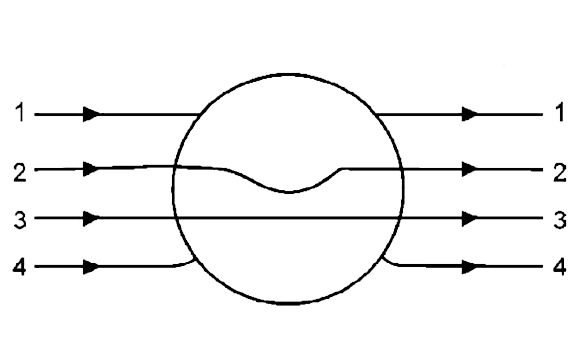 02:17View Solution
02:17View SolutionA dielectric slab of thickness `d` is inserted in a parallel plate capacitor whose negative plate is at `x=0` and positive plate is at `x = 3d`. The slab is equidistant from the plates. The capacitor is given some charge. As one goes from `0` to `3d(1998)`.
03:14View SolutionA charge `+q` is fixed at each of the points `x=x_0`, `x=3x_0`, `x=5x_0`,…………`x=oo` on the x axis, and a charge `-q` is fixed at each of the points `x=2x_0`, `x=4x_0`, `x=6x_0`, …………`x=oo`. Here `x_0` is a positive constant. Take the electric potential at a point due to a charge Q at a distance r from it to be `Q//(4piepsilon_0r)`.Then, the potential at the origin due to the above system of
03:47View SolutionA positively charged thin metal ring of radius R is fixed in the xy plane with its centre at the origin O. A negatively charged particle P is released from rest at the point `(0, 0, z_0)` where `z_0gt0`. Then the motion of P is
05:42View SolutionA non-conducting solid sphere of radius R is uniformly charged. The magnitude of the electric filed due to the sphere at a distance r from its centre
04:20View SolutionAn ellipsoidal cavity is carved within a perfect conductor. A positive charge q is placed at the centre of the cavity. The points A and B are on the cavity surface as shown in the figure. Then
 05:35View Solution
05:35View SolutionA spherical symmetric charge system is centered at origin. Given, Electric potential
`V=(Q)/(4piepsilon_0R_0)(rleR_0)`, `V=(Q)/(4piepsilon_0r)(rgtR_0)`
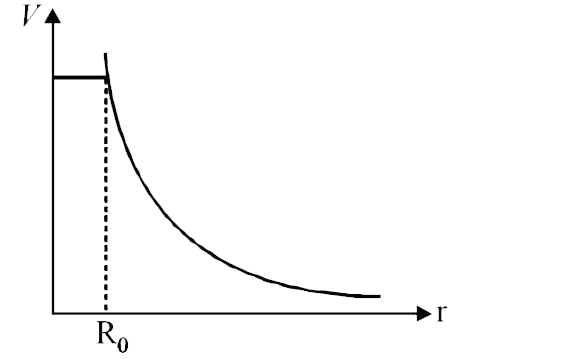 04:21View Solution
04:21View SolutionUnder the influence of the Coulomb field of charge `+Q`, a charge `-q` is moving around it in an elliptical orbit. Find out the correct statement(s).
03:25View SolutionA few electric field lines for a system of two charges `Q_1` and `Q_2` fixed at two different points on the x-axis are shown in the figure. These lines suggest that
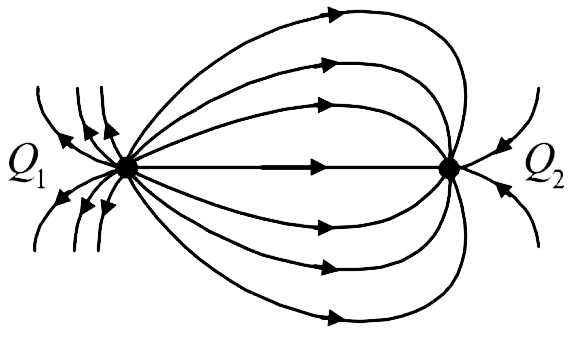 02:44View Solution
02:44View SolutionA spherical metal shell A of radius `R_A` and a solid metal sphere B of radius `R_B(ltR_A)` are kept far apart and each is given charge `'+Q'`. Now they are connected by a thin metal wire. Then
08:19View SolutionWhich of the following statement(s) is/are correct?
03:17View SolutionA cubical region of side a has its centre at the origin. It encloses three point charges , `-q` at `(0, -a//4 , 0),+3q at (0,0,0)` and `-q` at `(0,+a//4 ,0)`.
Choose the correct option (s)

(i) The net electric flux crossing the plane `x = +(q)/(2)` is equal to the net electric flux crossing the plane `x = -(a)/(2)`
(ii) The net electric flux crossing the plane `y = +(a)/(2)` is more than the net electric flux crossing the plane `y = -(a)/(2)`
(iii) The net electric flux crossing the entire region is `(q)/(epsilon_(0))`
(iv) The net electric flux crossing the plane `z = +(a)/(2)` is equal to the net electric flux crossing the plane `x = +(a)/(2)`02:35View SolutionSix point charges are kept at the vertices of a regular hexagon of side L and centre O, as shown in the figure. Given that `K=(1)/(4piepsilon_0)(q)/(L^2)`, which of the following statements(s) is (are) correct?
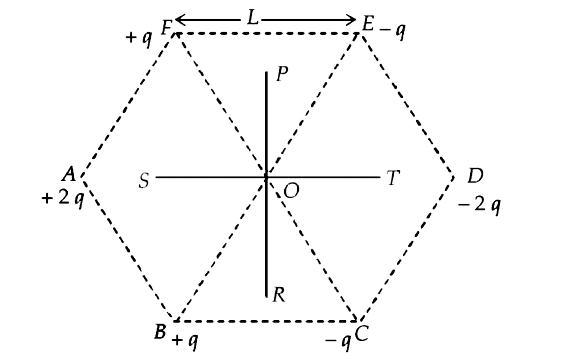 06:45View Solution
06:45View SolutionTwo non-conducting solid spheres of radii R and 2R, having uniform volume charge densities `rho_1` and `rho_2` respectively, touch each other. The net electric field at a distance 2R from the centre of the smaller sphere, along the line joining the centres of the spheres, is zero. The ratio `rho_1/rho_2` can be
05:06View SolutionIn the circuit shown in the figure, there are two parallel plate capacitors each of capacitance C. The switch `S_1` is pressed first to fully charge the capacitor `C_1` and then released. The switch `S_2` is then pressed to charge the capacitor `C_2`. After some time, `S_2` is released and then `S_3` is pressed. After some time
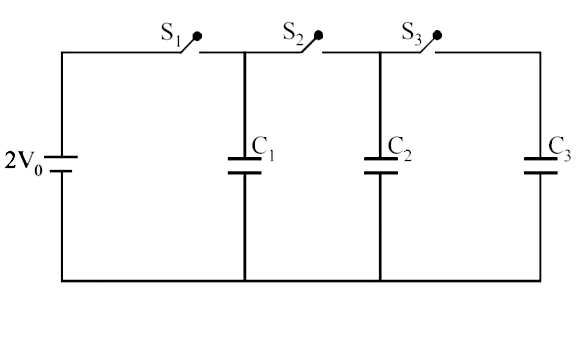 02:38View Solution
02:38View SolutionTwo non-conducting spheres of radii `R_(1)` and `R_(2)` and carrying uniform volume charge densities `+rho` and `- rho` respectively are placed such that they partially overlapping region.
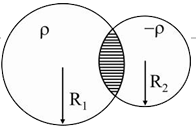 05:51View Solution
05:51View SolutionLet `E_1(r)`, `E_2(r)` and `E_3(r)` be the respectively electric field at a distance r from a point charge `Q`, an infinitely long wire with constant linear charge density `lambda`, and an infinite plane with uniform surface charge density `sigma`. If `E_1(r_0)=E_2(r_0)=E_3(r_0)` at a given distance `r_0`, then
08:18View SolutionA parallel plate capacitor has a dielectric slab of dielectric constant K between its plates that covers `1//3` of the area of its plates, as shown in the figure. The total capacitance of the capacitor is C while that of the portion with dielectric in between is `C_1`. When the capacitor is charged, the plate area covered by the dielectric gets charge `Q_1` and the rest of the area gets charge `Q_2`. The electric field in the dielectric is `E_1` and that in the other portion is `E_2`. Choose the correct option/options, ignoring edge effects.
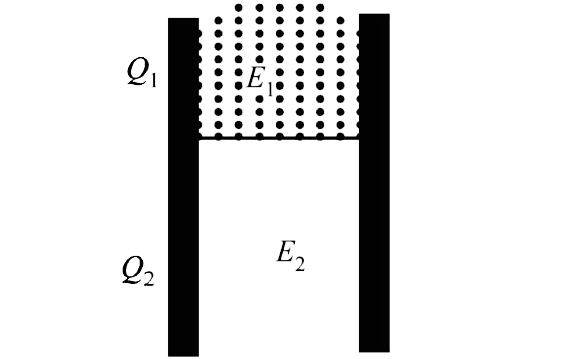 06:17View Solution
06:17View SolutionThe figure below depict two situations in which two infinitely long static line charges of constant positive line charge density `lambda` are kept parallel to each other. In their resulting electric field, point charges q and `-q` are kept in equilibrium between them. The point charges are confined to move in the x direction only. If they are given a small displacement about their equilibrium positions, then the correct statement(s) is(are)
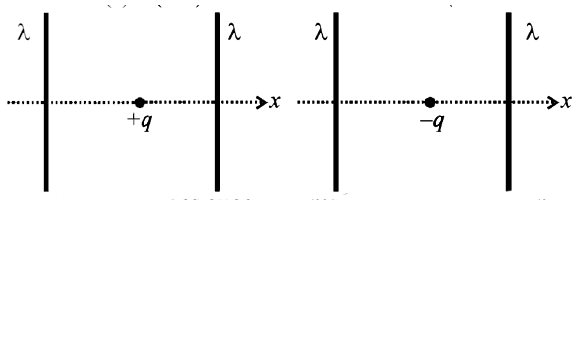 08:51View Solution
08:51View SolutionConsider a uniform spherical charge distribution of radius `R_(1)` centred at the origin `O`. In this distribution a spherical cavity of radius `R_(2)`, centred at `P` with distance `OP = a = R_(1) - R_(2)` (fig) is made.If the electric field inside the cavity at position `vec(r )`, then the correct statement is
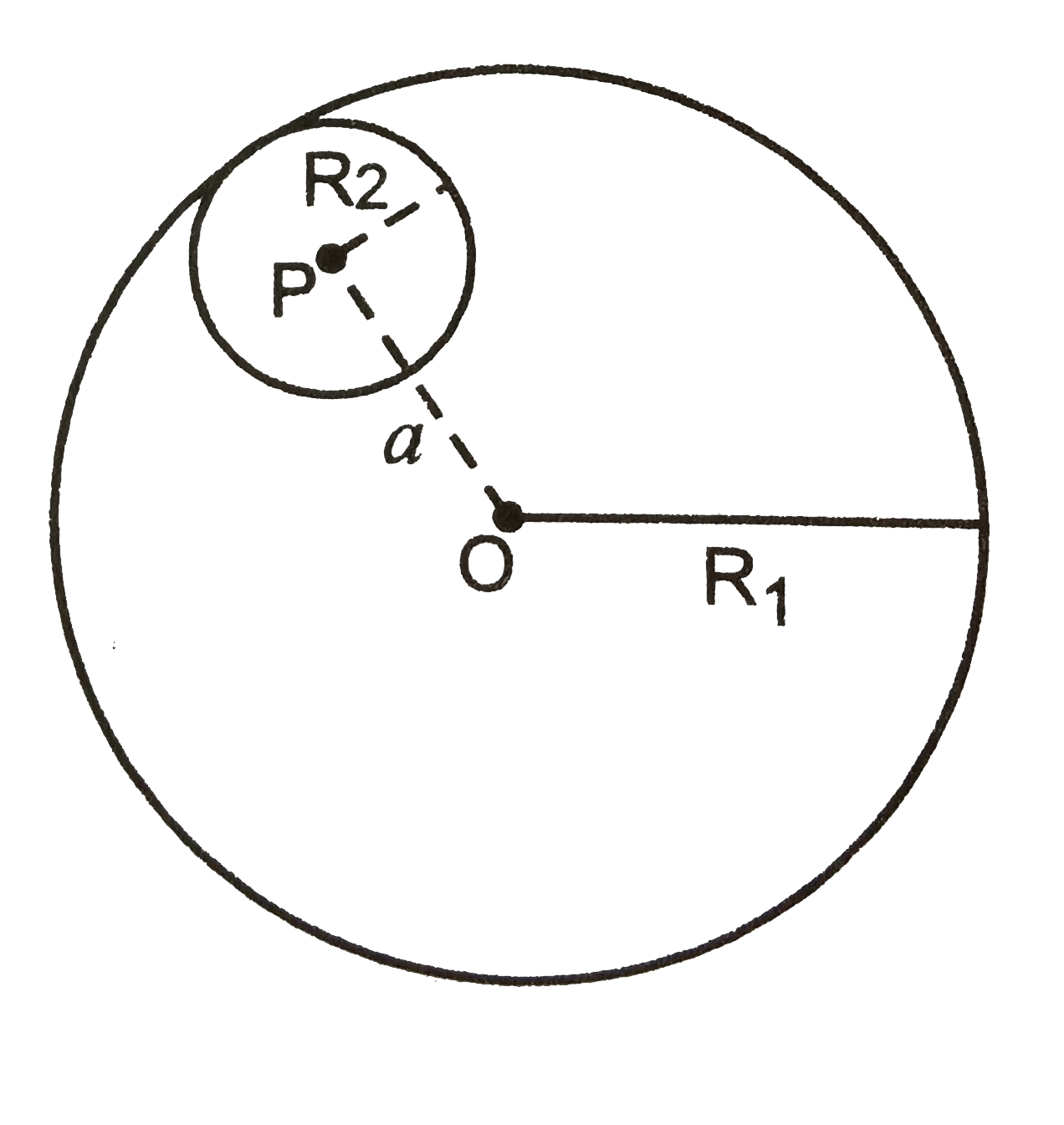 06:03View Solution
06:03View SolutionA parallel plate capacitor having plates of area S and plate separation d, has capacitance `C_1` in air. When two dielectrics of different relative primitivities (`epsilon_1=2` and `epsilon_2=4`) are introduced between the two plates as shown in the figure, the capacitance becomes `C_2`. The ratio `C_2/C_1` is
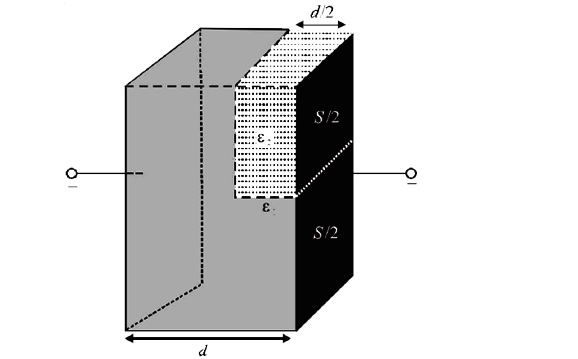 06:50View Solution
06:50View SolutionThree charges each of value q are placed at the corners of an equilateral triangle. A fourth charge Q is placed at the center of the triangle.
a. Find the net force on charge q.
b. If `Q = -q`, will the charges at the corners move toward the center or fly away from it ?
c. For what value of Q and O will the charges remain stationary ?
d. In situation (c), how much work is done in removing the charges to infinity ?12:20View SolutionA rigid insulated wire frame in the form of a right-angled triangle ABC is set in a vertical plane as shown in fig. two beads of equal masses m each and carrying charges `q_(1)` and `q_(2)` are connected by a cord of length l and can slide without friction on the wires.
Considering the case when the beads are stationary, determine
(i) the angel `alpha`
(ii) the tension in the cord, and
(iii) The normal reaction on the beads.
If the cord is now cut, what are the value of the charges for which the beads continue to remain stationary?
 10:46View Solution
10:46View SolutionA charge 'Q' is distributed over two concentric hollow spheres of radii 'r' and 'R' (gtr) such that the surface densities are equal. Find the potential at the common centre.
08:37View SolutionA thin fixed of radius 1 metre has a positive charge `1xx10^-5` coulomb uniformly distributed over it. A particle of mass 0.9 gm and having a negative charge of `1xx10^-6` coulomb is placed on the axis at a distance of 1cm from the centre of the ring. Show that the motion of the negatively charged particle is approaximately simple harmonic. Calculate the time period of oscillations.
06:01View SolutionThe figure shows two identical parallel plate capacitors connected to a battery with the switch S closed. The switch is now opened and the free space between the plates of the capacitors is filled with a dielectric of dielectric constant(or relative permittivity) 3. Find the ratio of the total electrostatic energy stored in both capacitors before and after the introduction of the dielectric.
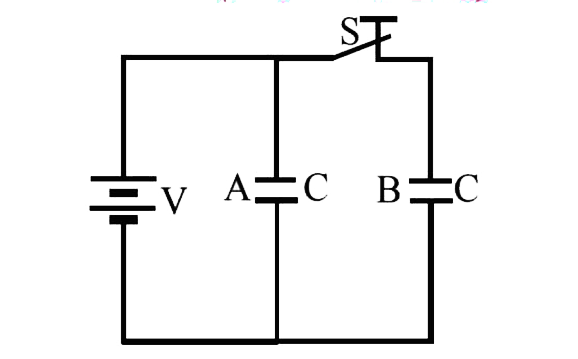 05:01View Solution
05:01View SolutionTwo fixed, equal, positive charges, each of magnitude `5xx10^-5` coul are located at points A and B separated by a distance of 6m. An equal and opposite charge moves towards them along the line COD, the perpendicular bisector of the line AB.
The moving charge, when it reaches the point C at a distance of 4m from O, has a kinetic energy of 4 joules. Calculate the distance of the farthest point D which the negative charge will reach before returning towards C.
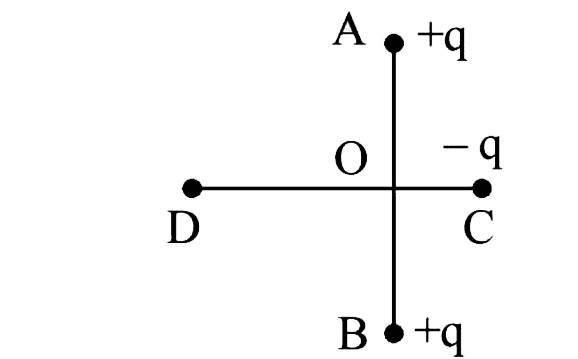 07:56View Solution
07:56View SolutionA point particle of mass M is attached to one end of a massless rigid non-conducting rod of length L. Another point particle of the same mass is attached to the other end of the rod. The two particles carry charges `+q` and `-q` respectively. This arrangement is held in a region of a uniform electric field E such that the rod makes a small angle `theta` (say of about 5 degree) with the field direction, fig. Find an expression for the minimum time needed for the rod to become parrallel to the field after it is set free.
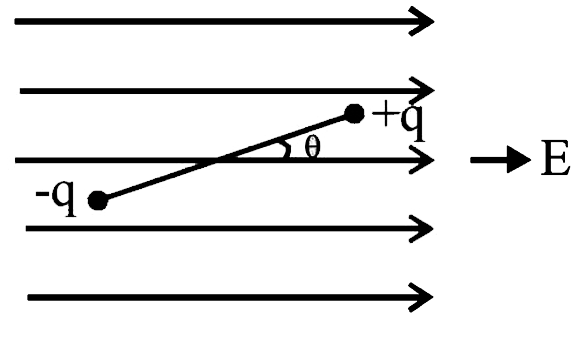 06:20View Solution
06:20View SolutionThree concentric spherical metallic shells A, B and C of radii a, b and c (a lt b ltc) have surface charge densities `sigma`, `-sigma` and `sigma` respectively.
`(i) Find the potential of the three shells A, B and C.
(ii) If the shells A and C are at the same potential, obtain the relation between the radii a, b and c.08:04View SolutionTwo charges `-2Q` abd `Q` are located at the points with coordinates `(-3a, 0)` and `(+3a, 0)` respectively in the x-y plane. (i) Show that all points in the x-y plane where the electric potential due to the charges is zero, on a circle. Find its radius and the location of its centre (ii) Give the expression V(x) at a general point on the x-axis and sketch the function V(x) on the whole x-axis. (iii) If a particle of charge +q starts from rest at the centre of the circle, shown by a short quantitative argument that the particle eventually crosses the circule. Find its speed when it does so.
11:27View Solution(i). A charge of Q coulomb is uniformly distributed over a spherical volume of radius R metre Obtain an expression for the energy of the system.
(ii). What will be the corresponding expression for the energy needed to completely diassemble the planet earth against the gravitational pull amongst its constituent particles? Assume the earth to be a sphere of uniform mass density. calculate the energy, given that the product of the mass and the radius of the earth to be `2.5xx10^(31)kg-m`04:36View SolutionTwo parallel plate capacitors A and B have the same separation `d=8.85xx10^-4m` between the plates. The plate area of A and B are `0.04m^2` and `0.02m^2` respectively. A slab of dielectric constant (relative permittivity) `K=9` has dimensions such that it can exactly fill the space between the plates of capacitor B.

(i) The dielectric slab is placed inside. A as shown in figure (a). A is then charged to a potential difference of 110V. Calculate the capacitance of A and the energy stored in it.
The battery is disconnected and then the dielectric slab is moved from A. Find the work done by the external agency in removing the slab from A.
(iii) The same dielectric slab is now placed inside B, filling it completely, The two capacitors A and B are then connected as shown in figure(c). Calculate the energy stored in the system.15:35View SolutionA circular ring of radius R with uniform positive charge density `lambda` per unit length is located in the y-z plane with its centre at the origin O. A particle of mass m and positive charge q is projected from the point P `(Rsqrt3, 0, 0)` on the positive x-axis directly towards O, with an initial speed v. Find the smallest (non-zero) value of the speed v such that the particle does not return to P.
07:11View SolutionTwo square metal plates of side `1 m` are kept `0.01 m` apart like a parallel plate capacitor in air in such a way that one of their edges is perpendicualr to an oil surface in the a tank filled with an insulating oil. The plates are connected to a battery of emf `55 V`. The plates are then lowered vertically into the oil at a speed of `0.001 ms^(-1)`. Calculate the current drawn from the battery during the process.
(Dielectric constant of oil `=11, epsilon_(0) = 8.85 xx 10^(-12) N^(-1) m^(-2))`.05:41View SolutionThe capacitance of a parallel plate capacitor with plate area `A` and separation `d` is `C`. The space between the plates in filled with two wedges of dielectric constants `K_(1)` and `K_(2)` respectively. Find the capacitance of resulting capacitor.
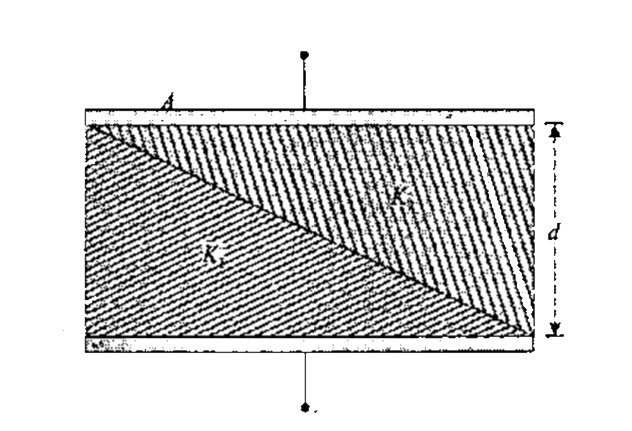 18:50View Solution
18:50View SolutionTwo capacitors `A` and `B` with capacities `3muF` and `2muF` are charged to a potential difference of `100 V` and `180V`, respectively. The plates of the capacitors are connected as show in figure with one wire of each capacitor free. The upper plate of `A` is positive and that of `B` is negastive. An uncharged `2muF` capcitor `C` with lead wires falls on the free ends to complete the circuit. Calculate
a. the final charge on the three capacitors.
b. the amount of electrostatic energy stored in the system before and after completion of the circuit.
 08:11View Solution
08:11View SolutionA conducting sphere `S_1` of radius `r` is attached to an insulating handle. Another conduction sphere `S_2` of radius `R` is mounted on an insulating stand. `S_2` is initially uncharged. `S_1` is given a charge `Q` brought into contact with `S_2` and removed. `S_1` is recharge such that the charge on it is again `Q` and it is again brought into contact with `S_2` and removed. This procedure is repeated `n` times.
a. Find the electrostatic energy of `S_2` after `n` such contacts with `S_1`.
b. What is the limiting value of this energy as `nrarroo` ?10:08View SolutionA nonconducting disk of radius a and uniform positive surface charge density `sigma` is placed on the ground, with its axis vertical. A particle of mass m and positive charge q is dropped, along the axis of the disk, from a height H with zero initial velocity. The particle has `q//m = 4 epsilon_(0) g// sigma`.
(i) Find the value of H if the particle just reaches the disk.
(ii) Sketch the potential energy of the particle as a function of its height and find its equilibrium position.19:24View SolutionCharges `+q` and `-q` are located at the corners of a cube of side as show in the figure. Find the work done to separate the charges to infinite distance
 08:35View Solution
08:35View SolutionA charge `+Q` is fixed at the origin of the co-ordinate system while a small electric dipole of dipolement `vecp` pointing away from the charge along the x-axis is set free from a point far away from the origin.
(a) Calculate the K.E. of the dipole when it reaches to a point (d, 0).
(b) Calculate the force on the charge `+Q` at this moment.03:57View SolutionTwo uniformly charged large plane sheets `S_1` and `S_2` having charge densities `sigma_1` and `sigma_2` (`sigma_1gtsigma_2`) are placed at a distance d parallel to each other. A charge `q_0` is moved along a line of length a(altd) at an angle `45^@` with the normal to `S_1`. Calculate the work done by the electric field
03:51View SolutionA conducting liquid bubble of radius a and thickness ` t ( tltlt a)` is charged to potential `V`. If the bubble collapses to a droplet , find the potential on the droplet .
07:06View SolutionThe nuclear charge (`Ze`) is non uniformlly distribute with in a nucleus of radius r. The charge density `rho(r)` (charge per unit volume) is dependent only on the radial distance r form the centre of the nucleus s shown in figure. The electric field is only along the radial direction.

The electric field at `r=R` is04:13View SolutionThe nuclear charge (`Ze`) is non uniformlly distribute with in a nucleus of radius `r`. The charge density `rho(r)` (charge per unit volume) is dependent only on the radial distance r form the centre of the nucleus s shown in figure. The electric field is only along the radial direction.

For a=0 the value of d (maximum value of `rho` as shown in the figure) is
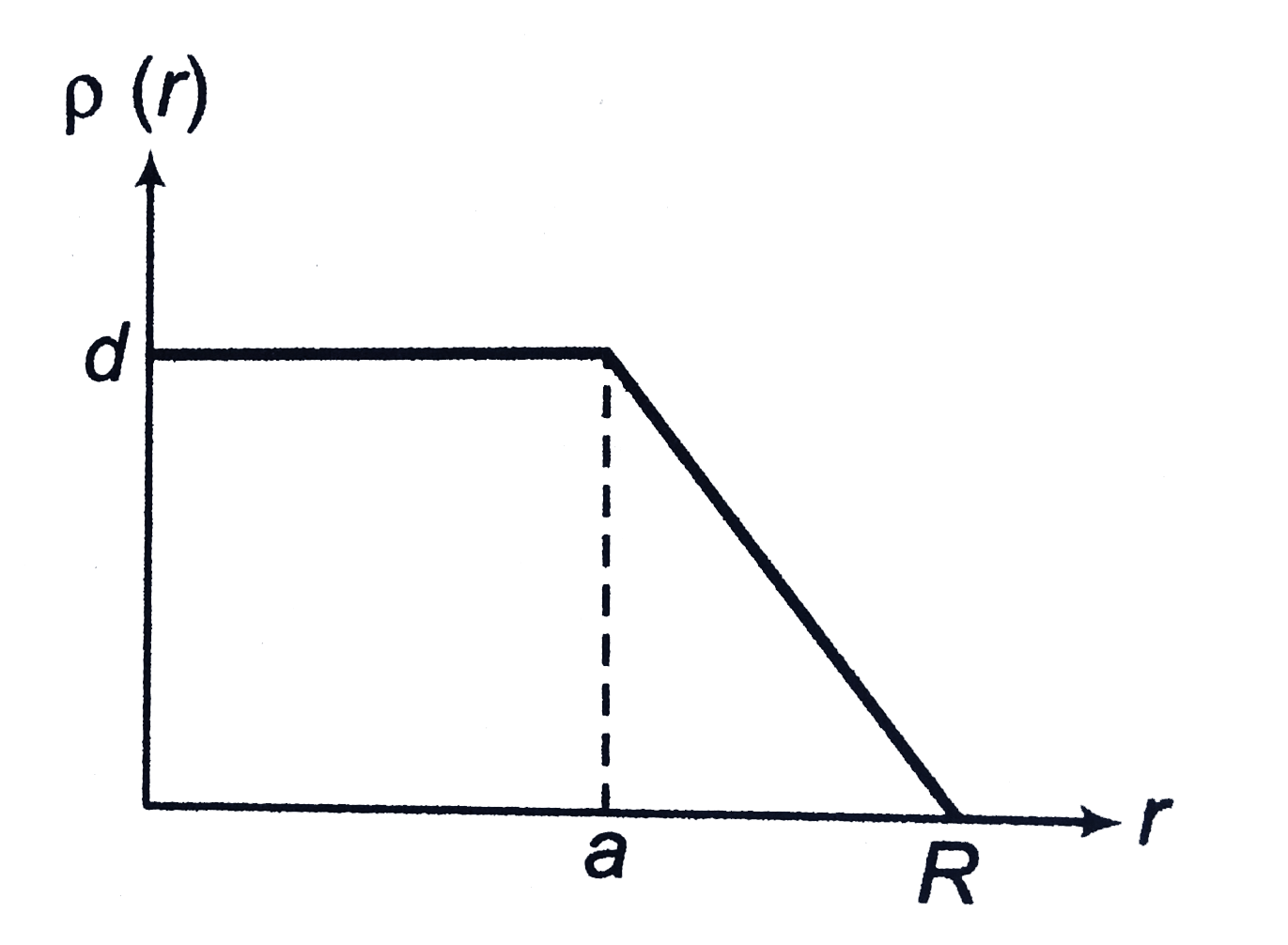 02:27View Solution
02:27View Solution
JEE Main And Advanced questions and complete solutions for chapter ELECTROSTATICS of SUNIL BATRA 41 YEARS IITJEE PHYSICS (HINGLISH) of Class 12
